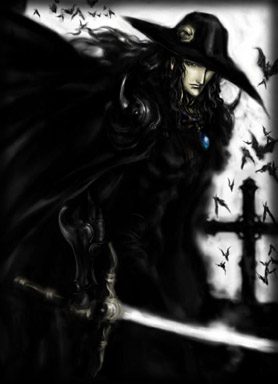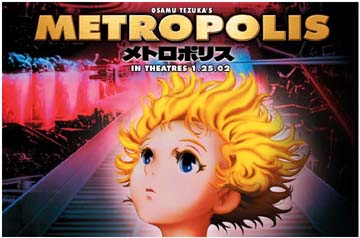
Milton Streeter
In the Suginami-ku district of Tokyo, there stands a building among the many
other tall buildings. Although it looks ordinary, inside this particular
building are strange things. There are demons who help save the world, and
cybernetic men who battle in the name of justice. There are travelers seeking
to return home...and a little girl trying to correct the mistake she made.
This is the home of Mad House studios...and I was there.
Mad House was founded in October 1972, separating from Osamu Tezuka’s Mushi Productions. One of the leading animation production studios in the world, their work is particularly famous for its high quality and attention to detail. A brief look at Mad House's work includes Record of Lodoss War, Urusei Yatsura: Always My Darling, and Tokyo Babylon. The company is also famous for its frequent trips into the dark side of anime, producing fast-paced, often violent thrillers such as The Dagger of Kamui, Demon City Shinjuku, and Perfect Blue. In March 1989, the studio won an award at the 6th Japan Animation Prize Festival by raising the standards of quality for the industry.
I met my contact Ms. Mukai at Shinjuku station. With her was Mr. Yoshinobu Inano, an animator/artist of considerable reputation. You may not know his name, but you certainly know his work; he was key animator for Wings of Honneamise, the Macross and Dirty Pair movies, and did the layouts for that modern anime classic, Akira. He has also done character designs, modeling and animation for the Macross VF-X and Silent Mobius video games. A very charming fellow, the three of us talked about subjects as diverse as anime to life in San Francisco while on the train.
Upon arrival at the studio, I stepped through the door and the first thing
that greeted my eyes was a theatrical poster for Wicked City, a 1987
movie that is probably Mad House's best-known production in North America.
The “black widow” sequence in that movie I have always regarded as one of
anime's truly scary moments, and seeing the poster reminded me of what is
made in this place.
The second thing to greet my eyes was Mr.Yuichiro Saito, the studio's
Production Manager. He showed me around, allowing me to see the animators at
work. Of particular interest were the cel painters, still wearing white
gloves and masks, and using acrylic paints. One 3-tiered shelf must have held
over 300 jars! Mr. Saito informed me that they were in the process of
changing over to computers: "It will give us more variety." He then showed me
volume after volume of folios. Each folio contained dozens of cel paintings
from their many projects. I was almost drooling with delight as I looked at
the actual cels used in Wicked City, X, and Ninja Scroll.
I also had a glimpse of other staffers as well, in their cubicles. It looked
much like any office anywhere in the world...except most offices don't have a
Gundam model standing on the radio. Despite the studio’s name, there were no
signs of madness at all. Here and there on the walls were framed posters of
some of their productions. In addition to Wicked City there was also
Jubei-chan, Card Captor Sakura and another I didn't recognize.
Two of their newest releases were also displayed; one was Metropolis,
resembling the famous science fiction movie from 1926. The other was-well,
I'll get to that in a moment.
Near the front entrance is also a shelf lined with videos. They are of Mad
House's own productions, of course, and I knew many of them. Golgo 13:
Queen Bee was there, and so was Phantom Quest Corps (Yugen Kaisha).
Card Captor Sakura was a surprise, though; this studio is known more
for gritty, horrific titles, not that of a little girl playing Pandora! Mr.
Saito laughed when I remarked on this, replying "Yes, it was something
different for us too." He then asked me if I’d like a look at their new
project, and I eagerly accepted.

They set me in front of a large TV and showed me a trailer of the new
Vampire Hunter D movie. Like most fans, I've seen the original film,
and while I liked it well enough, I sometimes felt something was missing.
Apart from D himself, much of the characters and settings just didn't seem
spooky enough. That complaint is over now. In 3 minutes of watching the
trailer, I got chills! The skillful use of light and shadow is one way
Japanese anime is different from American animation, and this movie shows
exactly how it should be done.
Not only light and shadow, but color and even camera angles are blended in a
way that in real life was done only by people such as...oh, Hitchcock,
perhaps. Even if you know VHD's story (and I’m not certain whether
it's been changed), you’ll be impressed all over again. Oh, did I mention
that the trailer was narrated in English, too?
I was then introduced to the person most responsible for what I'd just seen:
Mr. Yoshiaki Kawajiri. As a director, he has nearly a dozen productions to
his credit, and he both wrote and directed Vampire Hunter D. You're
all familiar with some of his other works: Akira, Goku: Midnight
Eye, Lensman (both the movie and the TV series), Cyber City
Oedo 808, Ninja Scroll. Note that, except for Lensman, all of the
above titles are "dark" anime. There's a reason for this. Kawajiri is
also an artist of considerable talent, and had much to do with the "look" of
the films he directed. His character designs abandon the big-eyed look so
common in anime, creating people who are leaner, more stylish, and
always dangerous-looking.
Kawajiri-san was very enthusiastic about the new Vampire Hunter D. The
result of two years' work, the film had just been released when I spoke with
him.
M: What is the major difference between the first VHD and this one?
K: Nearly everything. The original D was made for video. This one was designed
as a theatrical movie release, so we had the opportunity to do more. The
settings are more complete, the characters more refined, and the atmosphere
is deeper.
M: What was the greatest difficulty in making this film?
K: To produce a more compelling film. Vampire Hunter D is a known character, so we
had to tell the story in a more complete way.
M: There are vampire legends in Japan, but this has a purely Western feel to it. Did
you incorporate elements from both cultures?
K: No. Everyone is familiar with the Nosferatu or Dracula style of
vampires. Visually, they’re much more impressive, and we saw no reason to change that.
M: How does it feel seeing your work come to life on-screen?
K: (laugh) I feel relieved...and wonder what audiences will think of it.

A short while later, I was shown a trailer for Metropolis. As I said earlier, this
bore some resemblance to the Fritz Lang film from 1926, mostly in its visual style. Using
traditional animation blended with the latest CG techniques, the results are very
interesting. Both the characters and story are from a work by Osamu Tezuka, and I
thought that the two styles would not blend together, but I was wrong. The computer
graphics gave a sense of remoteness; the skyscraper that dominates the city is tall and
sterile and mechanical and cold. It very much reflects the man who built it. The lower city,
on the other hand, is organic--dirty and warm and very much alive; that is what the
traditional animation emphasizes. But what I remember most is the music, which included
an early-1960s ballad, “I Can’t Stop Loving You” by Ray Charles.
The story of Metropolis is very much in line with Dr. Tezuka’s philosophy of
compassion for all living beings and how people must not become tools of their tools.
Metropolis is a shining super-city where men and robots live together...as long as each
stays in his place. All the human drama associated with Tezuka’s work is displayed here,
without ever being heavy-handed or preachy.
I did not know it at the time, but there were other well-known figures involved in the
film’s production: Katsuhiro (Akira, Memories) Otomo, who wrote the
screenplay, and Rin Taro, a respected director whose animation credits go all the way
back to the first Galaxy Express 999 movie, in 1980.
Both Vampire Hunter D and Metropolis have been seen at film festivals across the world (including here in Honolulu). The former opened last autumn in limited release, and Metropolis will have its American premiere on January 25, 2002 in Los Angeles. And in a last-minute change of heart, The Academy of Motion Picture Arts and Sciences has decided to allow Vampire Hunter D to enter the lists for both Best Feature Film and Best Animated Film...so it’s possible that D might take home an Oscar this year. Wouldn’t that be a boost for anime!
We extend our sincere thanks to Ms. Masako Mukai of Region Free Japan, and especially Mr. Yuichiro Saito and the staff of Studio Mad House.